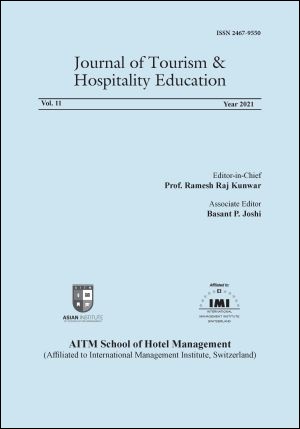Exploring the Prospective of Dark Tourism in Pashupatinath: A Hindu Pilgrimage Site, Nepal
DOI:
https://doi.org/10.3126/jthe.v11i0.38248Keywords:
Dark tourism, cremation, Pashupatinath, commodification, moral disengagementAbstract
A unique and increasingly pervasive feature within the tourism landscapes in the post-modern world is the special interests of tourists in death and anything associated with death. It is often believed that those who indulge in death and disaster site tours could potentially awaken their spiritual journey. The visitor immersions, in the spaces of death, and the events that have taken place or are re-created, triggers social conscience, or some shared emotion or an experience of involvement, with the death event. Reckoning to this facet, Pashupatinath temple- a place of pilgrimage for the followers of Santana Vedic religion which shows the comprehensive aspect of Hindu death rituals, symbols and processes has been chosen. The study proposes the site as a dark tourism destination and explores the convergence of cultural heritage site, pilgrimage and death rituals in the area that is associated with its characterization- particularly with reference to the witnessing of live open pyre burning death rituals at the cremation ground (ghat) that exclusively showcases the eastern phenomenon of death-spectatorship exhibited by Hindu death ritual. Despite an immense influence of the site in the tourism industry, the eastern dark tourism potential induced by the site has not been recognized formally by the tourism stakeholders. Even though it is widely consumed by the western visitors as a tourist element. The phenomenon of Hindu death tradition in the ghats of Pashupatinath is inclusive of all the death-related rituals and is a threshold of transition and transgression, a place in between life and death. Henceforth, as the central tenet of dark tourism being “the death”, Hindu death rituals in Pashupatinath could be firmly brought into the realms of dark tourism discourse. The findings are based on the prevalence of push factors that encourages consumption of the proposed site as a dark tourist product in liminal conditions (an in-between position). To be more specific, the practice of intellectualization of emotion, convenience of visits, edutainment elements, practice of moral disengagement. The prospective of dark tourism in Pashupatinath, if entitled to the mere promotion of the crematory site, may send a negative connotation and raise moral and ethical concerns. Hence, tourism stakeholders should consciously introduce the phenomenon as an accompaniment to the popularized mainstream religious and cultural value of the site.
Downloads
Downloads
Published
How to Cite
Issue
Section
License
Copyright: The Authors
All rights reserved: No part of this publication may be reproduced or transmitted in any form or by any means-electronic or mechanical including photocopy, recording or any information storage and retrieval system-without permission in writing from the publisher




